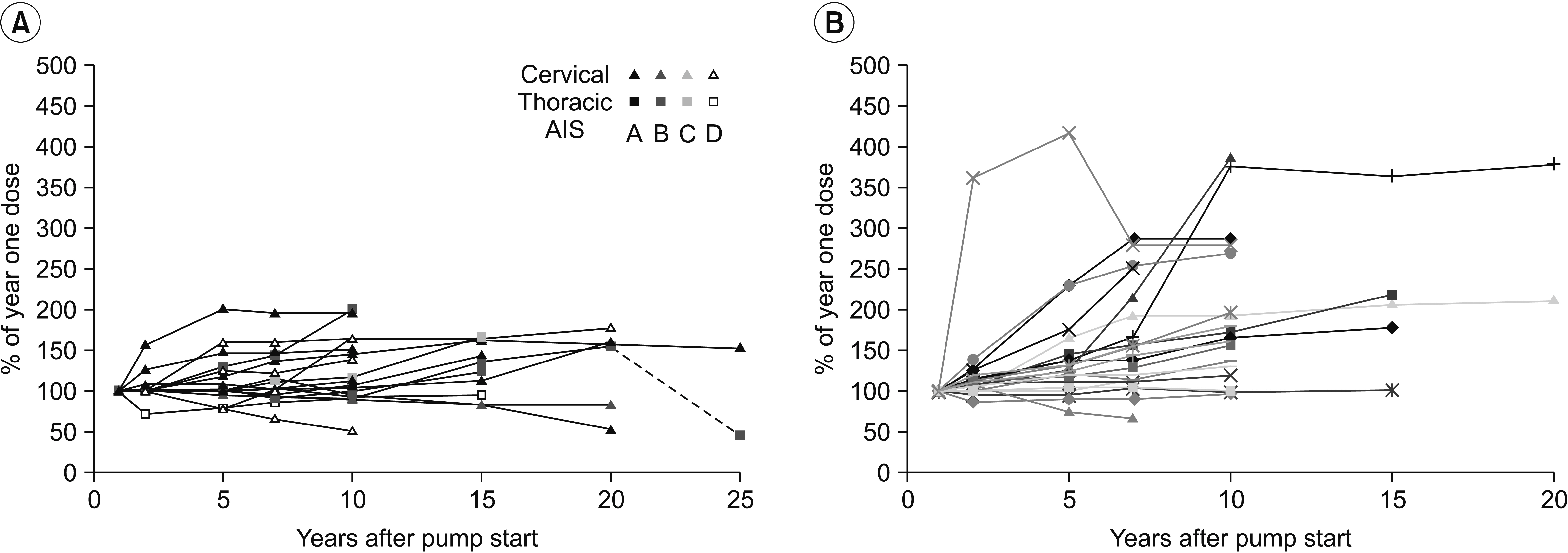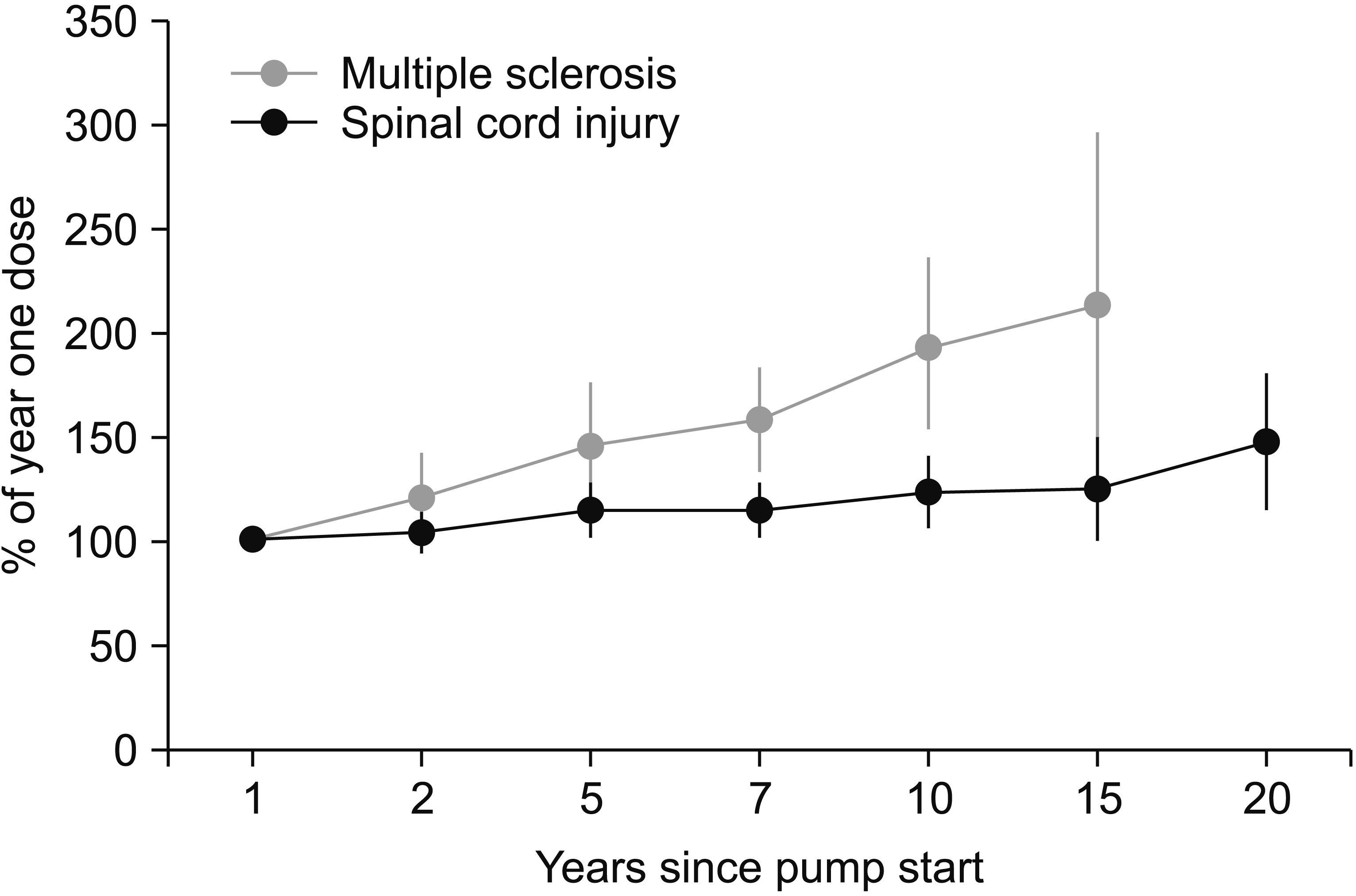Ann Rehabil Med.
2019 Oct;43(5):555-561. 10.5535/arm.2019.43.5.555.
Intrathecal Baclofen Dosage for Long-Term Treatment of Patients With Spasticity Due to Traumatic Spinal Cord Injuries or Multiple Sclerosis
- Affiliations
-
- 1Department of Clinical Neuroscience, Institute of Neuroscience and Physiology, The Sahlgrenska Academy, University of Gothenburg, Gothenburg, Sweden. bengt.skoog@vgregion.se
- 2Department of Neurology, Karolinska Hospital, Stockholm, Sweden.
- KMID: 2463703
- DOI: http://doi.org/10.5535/arm.2019.43.5.555
Abstract
OBJECTIVE
To investigate dosage changes in intrathecal baclofen during long-term treatment of patients with severe leg spasticity.
METHODS
We performed a retrospective chart review of 49 patients treated with an intrathecal baclofen pump (ITB) because of severe leg spasticity, for a minimum of 7 years. Eight patients were excluded due to catheter/pump failure or factors aggravating spasticity. Of the remaining 41 patients, 19 had spinal cord injury (SCI) and 22 were diagnosed with multiple sclerosis (MS). Among the SCI patients, 15 had cervical and 4 thoracic SCI, with 7 patients showing the American Spinal Injury Association impairment scale (AIS) A and 12 patients with AIS B-D. The dose was regulated by discussion among the patients and their physicians, usually 4-10 times annually, to reduce leg spasticity and also avoid leg/trunk weakness.
RESULTS
After 1 year patients on ITB needed a median dose of 168 mg/24 hr (range, 30-725 mg) for an optimal effect. After 7 to 10 years the dosage needed to reduce leg spasticity in the MS patients was significantly increased compared with the initial dose (mean 157%, n=22 and mean 194%, n=18). In contrast, the SCI patients needed only a modest increase (mean 113% and 121%). The difference between MS and SCI patients was significant (t-test p=0.006 and p=0.004).
CONCLUSION
The increased dosage in MS patients compared with patients diagnosed with SCI probably reflects the progressive disease course. The need for a large dosage increase in patients with SCI suggests possible pump failure, triggering factors for spasticity or progressive spinal disease.
MeSH Terms
Figure
Reference
-
1. Lance JW. Symposium synopsis. In : Feldman RG, Young RR, Koella WP, editors. Spasticity: disordered motor control. Chicago: Year Book Medical Publishers;1980. p. 484–94.2. Skold C, Levi R, Seiger A. Spasticity after traumatic spinal cord injury: nature, severity, and location. Arch Phys Med Rehabil. 1999; 80:1548–57.3. Lechner HE, Frotzler A, Eser P. Relationship between self- and clinically rated spasticity in spinal cord injury. Arch Phys Med Rehabil. 2006; 87:15–9.
Article4. Pandyan AD, Gregoric M, Barnes MP, Wood D, Van Wijck F, Burridge J, et al. Spasticity: clinical perceptions, neurological realities and meaningful measurement. Disabil Rehabil. 2005; 27:2–6.
Article5. Burns AS, Lanig I, Grabljevec K, New PW, Bensmail D, Ertzgaard P, et al. Optimizing the management of disabling spasticity following spinal cord damage: the ability network: an international initiative. Arch Phys Med Rehabil. 2016; 97:2222–8.6. Maynard FM, Karunas RS, Waring WP 3rd. Epidemiology of spasticity following traumatic spinal cord injury. Arch Phys Med Rehabil. 1990; 71:566–9.7. Penn RD. Intrathecal baclofen for spasticity of spinal origin: seven years of experience. J Neurosurg. 1992; 77:236–40.
Article8. Ordia JI, Fischer E, Adamski E, Chagnon KG, Spatz EL. Continuous intrathecal baclofen infusion by a programmable pump in 131 consecutive patients with severe spasticity of spinal origin. Neuromodulation. 2002; 5:16–24.
Article9. Azouvi P, Mane M, Thiebaut JB, Denys P, Remy-Neris O, Bussel B. Intrathecal baclofen administration for control of severe spinal spasticity: functional improvement and long-term follow-up. Arch Phys Med Rehabil. 1996; 77:35–9.
Article10. Coffey JR, Cahill D, Steers W, Park TS, Ordia J, Meythaler J, et al. Intrathecal baclofen for intractable spasticity of spinal origin: results of a long-term multicenter study. J Neurosurg. 1993; 78:226–32.
Article11. Skoog B, Runmarker B, Winblad S, Ekholm S, Andersen O. A representative cohort of patients with nonprogressive multiple sclerosis at the age of normal life expectancy. Brain. 2012; 135(Pt 3):900–11.
Article12. Rekand T, Gronning M. Treatment of spasticity related to multiple sclerosis with intrathecal baclofen: a longterm follow-up. J Rehabil Med. 2011; 43:511–4.
Article13. Natale M, D’Oria S, Nero VV, Squillante E, Gentile M, Rotondo M. Long-term effects of intrathecal baclofen in multiple sclerosis. Clin Neurol Neurosurg. 2016; 143:121–5.
Article14. Heetla HW, Staal MJ, Kliphuis C, van Laar T. The incidence and management of tolerance in intrathecal baclofen therapy. Spinal Cord. 2009; 47:751–6.
Article15. Draulans N, Vermeersch K, Degraeuwe B, Meurrens T, Peers K, Nuttin B, et al. Intrathecal baclofen in multiple sclerosis and spinal cord injury: complications and long-term dosage evolution. Clin Rehabil. 2013; 27:1137–43.
Article16. Nielsen JF, Hansen HJ, Sunde N, Christensen JJ. Evidence of tolerance to baclofen in treatment of severe spasticity with intrathecal baclofen. Clin Neurol Neurosurg. 2002; 104:142–5.
Article17. Zahavi A, Geertzen JH, Middel B, Staal M, Rietman JS. Long term effect (more than five years) of intrathecal baclofen on impairment, disability, and quality of life in patients with severe spasticity of spinal origin. J Neurol Neurosurg Psychiatry. 2004; 75:1553–7.
Article18. Voerman GE, Erren-Wolters CV, Fleuren JF, Hermens HJ, Geurts AC. Perceived spasticity in chronic spinal cord injured patients: associations with psychological factors. Disabil Rehabil. 2010; 32:775–80.
Article
- Full Text Links
- Actions
-
Cited
- CITED
-
- Close
- Share
- Similar articles
-
- Effects of Intrathecal Baclofen on Spasticity
- Effect of Clonidine on Spasticity in Patients with Spinal Cord Injury
- The Effect of Intrathecal Baclofen Injection on Muscle Stretch Reflex in Spinal Cord Injured Rabbit
- The effect of intrathecal baclofen single injection on neuropathic pain
- Intrathecal Baclofen for Spasticity: Changes in Clinical Feature and Gait




